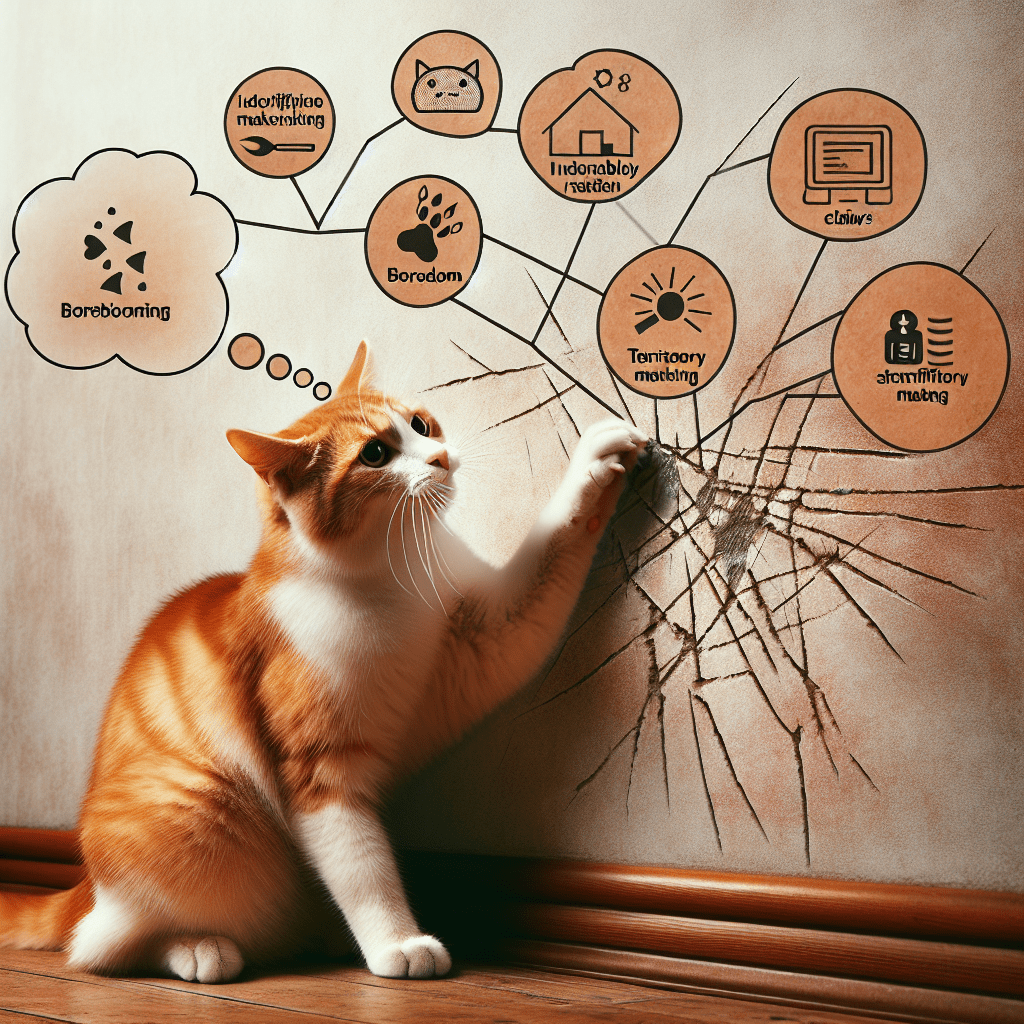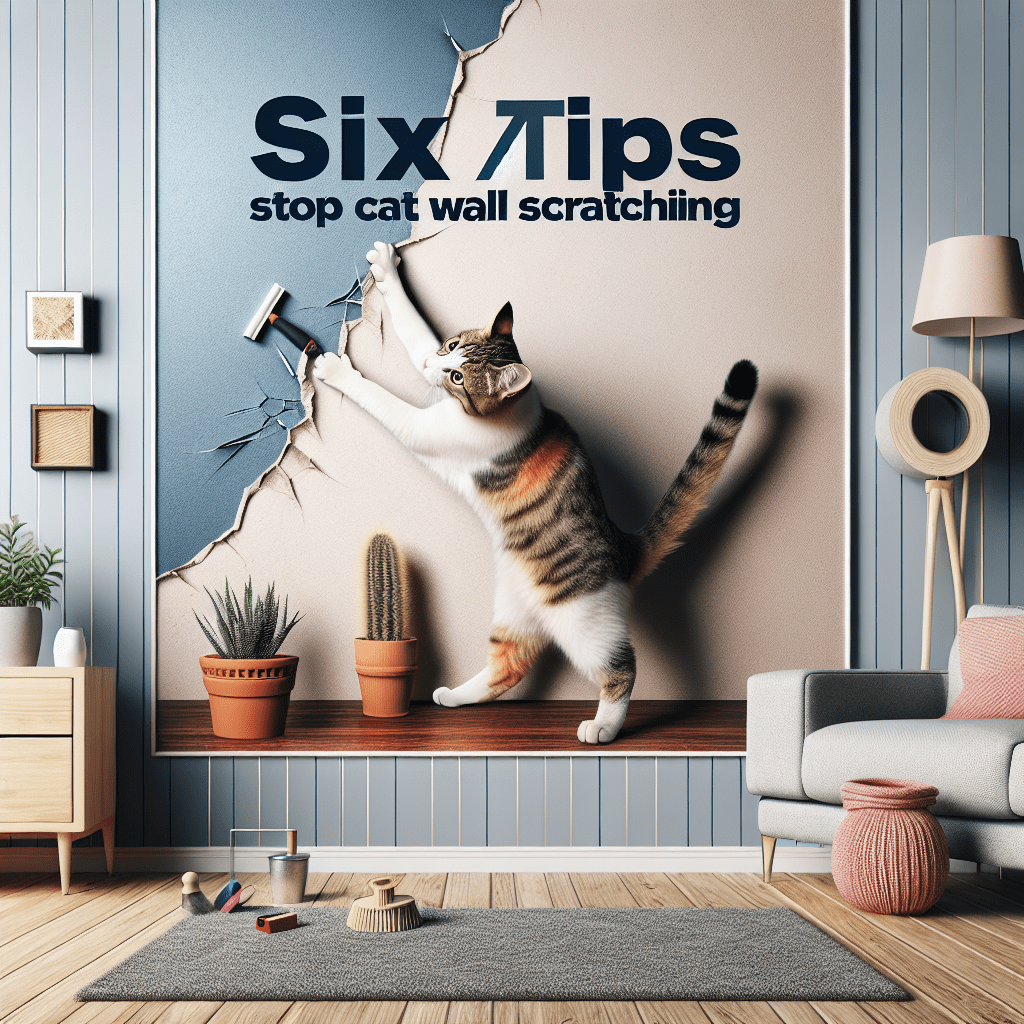Introduction Stop Cat Wall Scratching
Is your furry feline obsessed with turning your walls into a scratching post? You’re in good company! Countless pet parents deal with the same dilemma of cats using walls and furniture as their nail salon. Although it can be exasperating, delving into the reasons behind this habit is vital to finding a solution. Dive into this blog post to uncover why cats scratch and discover effective strategies to save your walls from their claws!
Table of Contents
Understanding Cat Behavior
Why Do Cats Scratch?
Cats scratch for several reasons, and it’s a natural and instinctive behaviour. Scratching helps cats mark their territory, as it leaves both visual and scent markers from the glands in their paws. This behaviour is essential for communication among cats.
Grooming Claws
Scratching is super important for cats when it comes to grooming their claws. It helps remove the dead outer layer, keeping those claws sharp and healthy. Plus, scratching lets cats stretch their muscles and flex their paws, which is great for their physical health.
Expression of Feelings
Sometimes, scratching can be a way for cats to express their emotions. Whether they’re excited, stressed, or bored, scratching provides an outlet for these feelings. Understanding these underlying reasons can help you address the behaviour more effectively.

6 Reasons Why and How to Stop It
Territorial Marking
Reason: Cats scratch surfaces to mark their territory. Their paw glands’ visual scratch marks and scent deposits signal ownership to other cats.
Solution: Provide your cat with designated scratching posts or pads. Place them strategically in areas where your cat frequently scratches. This redirects their behaviour to an acceptable surface.
Claw Maintenance
Reason: Scratching is a natural way for cats to groom and maintain their claws. This behaviour helps remove dead layers and keeps their claws sharp.
Solution: Regularly trim your cat’s claws to reduce their need to groom them through scratching. Also, ensure their scratching posts are made of materials like sisal that are effective for claw maintenance.
Physical Exercise
Reason: Scratching allows cats to stretch their muscles and flex their paws, which is crucial for their physical health.
Solution: Encourage physical activity through interactive toys and climbing structures. Providing ample physical outlets can reduce their need to scratch walls and furniture.
Emotional Expression
Reason: Cats might scratch out of excitement, stress, or boredom. This behaviour acts as an emotional outlet.
Solution: Spice up your cat’s surroundings with toys, puzzles, and interactive play! This will help lessen their stress and anxiety levels. Engaging in regular playtime won’t just keep them entertained but also address their emotional needs and prevent any unwanted scratching habits.
Lack of Scratching Options
Reason: Cats might resort to scratching walls and other furniture if appropriate scratching options are unavailable.
Solution:
- Invest in multiple scratching posts and pads.
- Ensure they are stable and placed in high-traffic areas of your home.
- Experiment with different textures and heights to find what your cat prefers.
- Habitual Behavior
Reason: If a cat has been allowed to scratch walls, it may become a habit that is hard to break.
Solution: Discourage this behaviour with gentle deterrents like double-sided tape on scratching spots. Consistently guide your cat to more appropriate scratching surfaces and reward them for using them.
By understanding these reasons and implementing these solutions, you can effectively curtail your cat’s wall-scratching behaviour, ensuring a happier home for you and your feline companion.

Identifying the Root Cause
Observing Your Cat’s Behavior
To effectively stop your cat from scratching walls, observing their behaviour closely is essential. Note when and where they tend to scratch the most. Is it in response to specific activities or changes in the environment? Identifying these triggers can provide valuable insights.
Addressing the Root Cause
Instead of merely treating the symptoms, focus on addressing the root cause. If your cat scratches out of boredom, providing more mental and physical stimulation might be the solution. If stress is the trigger, identifying and minimizing the stressors in their environment can help.
Common Triggers
Common triggers for Wall scratching include changes in the household, new pets, or lack of scratching alternatives. By pinpointing these triggers, you can effectively tailor your approach to deter your cat from scratching walls.
Practical Solutions
Environmental Changes
One great way to prevent your cat from scratching walls is by switching things up in your space. Set up a mix of scratching posts and pads in various spots at home. Just make sure they’re strong and tall for your cat to get a good stretch!
Training Techniques
Teaching your cat to scratch in certain spots can be super effective. Give them treats and praise when they use the scratching posts. Just stick with it, and your cat will catch on eventually!
Redirecting Behavior
To shift your cat’s scratching habits, try giving them interactive toys and playing together. Toys like feather wands or laser pointers, which mimic prey, can help keep your cat entertained and lessen their wall-scratching urge.
Behavioural Training
Step-by-Step Guide to Training
Training your cat involves patience and consistency. Here’s a step-by-step guide to help you get started:
- Introduce Scratching Posts: Place scratching posts in areas where your cat likes to scratch.
- Use Positive Reinforcement: Go ahead and treat your cat with some goodies and praise when they use the scratching posts!
- Discourage Wall Scratching: Try using double-sided tape or aluminium foil on the spots your cat loves to scratch.
The Importance of Consistency
Consistency is critical when training your cat. Make sure everyone at home is on the same page. Mixed signals can confuse your cat and slow down the training.
Patience and Persistence
Training your cat takes time, so hang in there and stay persistent. Celebrate those little wins and keep encouraging good behaviour. With time and effort, your furry friend will get the hang of using the scratching posts!
Expert Tips
Tip 1: Choosing the Right Scratching Posts
Invest in high-quality scratching posts made from durable materials like sisal. Look for a variety of textures and heights to cater to your cat’s preferences. Some cats may prefer vertical posts, while others might favour horizontal scratching pads. A mix of both ensures your cat remains engaged and is more likely to use them.
Tip 2: Placement Matters
Position the scratching posts in high-traffic areas where your cat spends most of their time. Cats often scratch to mark territory, so placing posts near their favourite resting spots or prominent areas naturally attracts them. If your cat has a preferred scratching spot on the wall, place a post nearby to redirect the behaviour.
Tip 3: Encourage Use with Catnip
Try sprinkling some catnip on the scratching posts to make them more enticing. It can pique your cat’s curiosity and interest them in the new scratching spots. You could also opt for catnip sprays to get a similar result.
Tip 4: Regular Maintenance
Maintain your cat’scat’s scratching posts by regularly checking for wear and tear. Replace or repair worn-out posts to keep them practical and attractive for your cat. Additionally, rotating the posts around the house can help maintain your cat’s interest.
Tip 5: Consistent Training and Reinforcement
Make training consistent and reinforce good behaviour with rewards. Treats, praise, or even a favourite toy can encourage your cat to use the scratching posts. Avoid shouting or punishing your cat for scratching walls, as it can create stress and worsen the problem.
Tip 6: Monitor and Adjust
Keep an eye on your cat’s scratching habits and adjust as needed. If you notice your cat favoring a particular post or area, consider adding more similar options. Flexibility and responsiveness to your cat’s preferences and behaviors can significantly enhance the effectiveness of your efforts.
Following these pro tips can help your cat get better at scratching. It’ll make your home life much more peaceful for you and your feline pal!
When to Seek Professional Help
Recognizing Persistent Issues
If your cat keeps scratching walls even after you’ve tried everything, it might be a good idea to get some professional help. Persistent behaviour problems could mean deeper issues that need an expert’s touch.
Working with a Certified Cat Behaviorist
If you’re struggling with your cat’s behaviour, a certified cat behaviourist is your go-to! They’ll give you personalized advice and solutions that fit your cat’s needs perfectly. You’ll pinpoint triggers together and devise a solid plan to tackle those behaviours head-on.
Benefits of Professional Guidance
Professional guidance can give you peace of mind and ensure you’re on the right track to tackle your cat’s scratching habits. A behaviourist can provide helpful tips and support every step of the way.
Conclusion
Understanding why cats scratch walls and tackling the root cause is critical to fixing this habit. Watch your cat, tweak the surroundings, and give praise to steer them away from scratching walls. And hey, remember, patience and being consistent are crucial here. If you’re stuck, seek pro help to ensure the best for you and your furry buddy.
Ready to spruce up your place and end your cat’s Wall scratching? Drop your stories and extra tips in the comments below. Let’s team up to make a happy, scratch-free zone for our furballs!
Frequently Asked Questions (FAQ)
Why does my cat scratch walls even though I have multiple scratching posts?
Cats may scratch walls despite the availability of scratching posts for various reasons such as habit, preference for the Wall’s texture, and Insufficient variety in the scratching posts. Ensure that the scratching posts are stable, placed in high-traffic areas, and offer different textures and heights to cater to your cat’s preferences.
Can declawing stop my cat from scratching walls?
Declawing cats? Not a great plan. It’s like chopping off their toe bones, which can hurt and lead to behavior issues. Why not offer good scratching posts and show them how to use those instead?
How long does it take to train a cat to stop scratching walls?
Training duration differs based on your cat and how often you train. It might take a few weeks to a few months to notice big improvements. Stay patient, keep at it, and reward good behaviour for successful training!
What type of scratching posts are most effective?
Cats have different preferences, so providing various scratching posts is important. Tall and sturdy posts allowing the cat to stretch fully are typically the most effective. Different textures like sisal rope, cardboard, and carpet can also appeal to different cats.
Should I use deterrent sprays to stop my cat from scratching walls?
Deterrent sprays can help, but it’s important to be careful since some cats might not react well to certain chemicals. Try a tiny bit first and see how your cat responds. Mix deterrents with positive reinforcement and good training methods for the best outcome.
When should I seek professional help for my cat’s scratching behaviour?
If your cat keeps scratching the walls no matter what you try, it could be a good idea to get some pro help. A certified cat behaviorist can give you personalized tips, figure out what’s causing it, and work with you on a solid plan to tackle the issue.
Sarah Smith is a passionate dog and cat enthusiast, blogger, and pet care expert. With years of experience researching and writing about various dog breeds cat breeds, she brings a wealth of knowledge and insight to her blog, PetPession.com. Sarah loves exploring the unique traits, histories, and care needs of different breeds, helping pet owners make informed decisions. Her mission is to create helpful, friendly, and well-researched content that both educates and celebrates the joy of pet ownership. When she’s not writing, Sarah enjoys outdoor adventures with her own furry friends.

